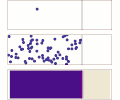Molecular diffusion
Molecular diffusion is a fundamental process in physics and chemistry, describing the random motion of particles in a medium (such as a gas, liquid, or solid) due to their kinetic energy. This process results in the mixing of the particles, leading to a net transport of matter from regions of higher concentration to regions of lower concentration, a process known as diffusion.
Overview[edit]
Molecular diffusion is a result of the random thermal motion of particles, which was first postulated by Robert Brown in the 19th century. This motion results in a net flow of particles from regions of higher concentration to regions of lower concentration, until a state of equilibrium is reached.
The rate of diffusion is determined by several factors, including the size of the particles, the temperature of the medium, and the concentration gradient. The mathematical description of diffusion is given by Fick's laws of diffusion, which relate the diffusion flux to the concentration gradient.
Mechanism[edit]
The mechanism of molecular diffusion can be understood in terms of the kinetic theory of gases. According to this theory, particles are in constant random motion due to their thermal energy. This motion results in collisions between particles, which lead to a redistribution of their kinetic energy and a mixing of the particles.
In a system at equilibrium, there is no net flow of particles, as the random motion of the particles results in an equal number of particles moving in all directions. However, if there is a concentration gradient, there will be a net flow of particles from regions of higher concentration to regions of lower concentration.
Applications[edit]
Molecular diffusion has many applications in various fields, including physics, chemistry, biology, and engineering. For example, it is crucial in the transport of nutrients and waste products in biological systems, in the mixing of gases and liquids in chemical reactions, and in the spread of pollutants in the environment.
In chemical engineering, the principles of molecular diffusion are used to design and optimize processes such as distillation, absorption, and extraction. In medicine, understanding diffusion is important for drug delivery and the functioning of the human body at the cellular level.
See also[edit]
-
Molecular diffusion at micro and macro scales
-
Illustration of molecular diffusion
-
Self-diffusion process
-
Diffusion in a medium
-
Entropy and diffusion
Ad. Transform your life with W8MD's Budget GLP-1 injections from $75


W8MD offers a medical weight loss program to lose weight in Philadelphia. Our physician-supervised medical weight loss provides:
- Weight loss injections in NYC (generic and brand names):
- Zepbound / Mounjaro, Wegovy / Ozempic, Saxenda
- Most insurances accepted or discounted self-pay rates. We will obtain insurance prior authorizations if needed.
- Generic GLP1 weight loss injections from $75 for the starting dose.
- Also offer prescription weight loss medications including Phentermine, Qsymia, Diethylpropion, Contrave etc.
NYC weight loss doctor appointmentsNYC weight loss doctor appointments
Start your NYC weight loss journey today at our NYC medical weight loss and Philadelphia medical weight loss clinics.
- Call 718-946-5500 to lose weight in NYC or for medical weight loss in Philadelphia 215-676-2334.
- Tags:NYC medical weight loss, Philadelphia lose weight Zepbound NYC, Budget GLP1 weight loss injections, Wegovy Philadelphia, Wegovy NYC, Philadelphia medical weight loss, Brookly weight loss and Wegovy NYC
|
WikiMD's Wellness Encyclopedia |
| Let Food Be Thy Medicine Medicine Thy Food - Hippocrates |
Medical Disclaimer: WikiMD is not a substitute for professional medical advice. The information on WikiMD is provided as an information resource only, may be incorrect, outdated or misleading, and is not to be used or relied on for any diagnostic or treatment purposes. Please consult your health care provider before making any healthcare decisions or for guidance about a specific medical condition. WikiMD expressly disclaims responsibility, and shall have no liability, for any damages, loss, injury, or liability whatsoever suffered as a result of your reliance on the information contained in this site. By visiting this site you agree to the foregoing terms and conditions, which may from time to time be changed or supplemented by WikiMD. If you do not agree to the foregoing terms and conditions, you should not enter or use this site. See full disclaimer.
Credits:Most images are courtesy of Wikimedia commons, and templates, categories Wikipedia, licensed under CC BY SA or similar.
Translate this page: - East Asian
中文,
日本,
한국어,
South Asian
हिन्दी,
தமிழ்,
తెలుగు,
Urdu,
ಕನ್ನಡ,
Southeast Asian
Indonesian,
Vietnamese,
Thai,
မြန်မာဘာသာ,
বাংলা
European
español,
Deutsch,
français,
Greek,
português do Brasil,
polski,
română,
русский,
Nederlands,
norsk,
svenska,
suomi,
Italian
Middle Eastern & African
عربى,
Turkish,
Persian,
Hebrew,
Afrikaans,
isiZulu,
Kiswahili,
Other
Bulgarian,
Hungarian,
Czech,
Swedish,
മലയാളം,
मराठी,
ਪੰਜਾਬੀ,
ગુજરાતી,
Portuguese,
Ukrainian




